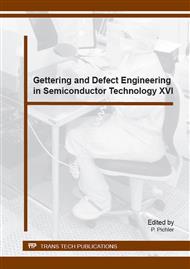[1]
S. Coffa et al., Diffusion and lifetime engineering in silicon, Nuclear Instruments and Methods in Physics Research B 74 (1993) 47.
Google Scholar
[2]
E. Badr, P. Pichler, and G. Schmidt, Modeling Platinum Diffusion in Silicon, J. Appl. Phys. 116 (2014) 133508.
DOI: 10.1063/1.4896909
Google Scholar
[3]
H. -J. Schulze, Influence of D-defects in FZ material used for power devices and their impact on lifetime and leakage current, Electrochem. Soc. Proc. 96-13 (1996) 289-304.
Google Scholar
[4]
E. Badr, P. Pichler and G. Schmidt: Deep Energy Levels of Platinum-Hydrogen Complexes in Silicon, Solid State Phenomena 205-206 (2014) 260-264.
DOI: 10.4028/www.scientific.net/ssp.205-206.260
Google Scholar
[5]
F. C. Frank and D. Turnbull, Mechanism of diffusion of copper in germanium, Phys. Rev. 104(3) (1956) 617-618.
DOI: 10.1103/physrev.104.617
Google Scholar
[6]
U. Gösele, W. Frank and A. Seeger, Mechanism and kinetics of the diffusion of gold in silicon, Appl. Phys. 23 (1980) 361-368.
DOI: 10.1007/bf00903217
Google Scholar
[7]
C. J. Ortiz, et al., A physically based model for the spatial and temporal evolution of self-interstitial agglomerates in ion-implanted silicon, J. Appl. Phys. 96(9) (2004) 4866-4877.
DOI: 10.1063/1.1786678
Google Scholar
[8]
M. Ullrich, A. Burenkov and H. Ryssel, Ion sputtering at grazing incidence for SIMS-analysis, Nuclear Instruments and Methods in Physics Research B, 228 (2005) 373-377.
DOI: 10.1016/j.nimb.2004.10.073
Google Scholar
[9]
M. D. Giles, Transient phosphorus diffusion below the amorphization threshold, J. Electrochem. Soc. 138(4) (1991) 1160-1165.
DOI: 10.1149/1.2085734
Google Scholar
[10]
C. Zechner et al., Accurate and efficient TCAD model for the formation and dissolution of small interstitial clusters and {311} defects in silicon, Materials Science and Engineering B 124-125 (2005) 401-403.
DOI: 10.1016/j.mseb.2005.08.010
Google Scholar
[11]
N. Zographos, C. Zechner, and I. Avci, TCAD Model for the evolution of interstitial clusters, {311} defects, and dislocation loops in silicon, Mat. Res. Soc. Symp. Proc. 994 (2007) 0994-F10-01.
DOI: 10.1557/proc-0994-f10-01
Google Scholar
[12]
N. Cowern et al., Energetics of Self-Interstitial Clusters in Si, Phys. Rev. Lett. 82(22) (1999) 4460-4463.
Google Scholar
[13]
P. A. Stolk et al, Physical mechanisms of transient enhanced dopant diffusion in ion-implanted silicon, J. Appl. Phys. 81(9) (1997) 6031-6050.
Google Scholar


